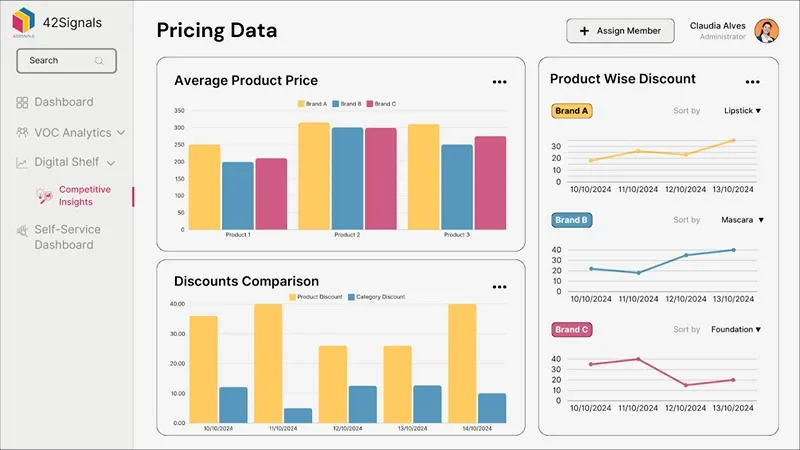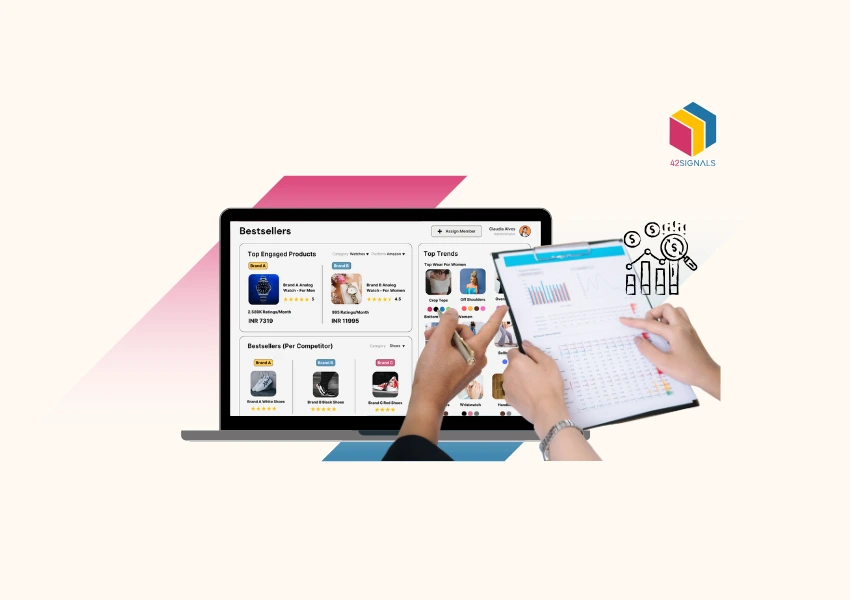With global e-commerce sales projected to surpass $6.5 trillion by 2025, businesses can no longer rely on intuition alone. Considering that, ecommerce product data has to be prompt and comprehensive for changes to be made proactively.

The reason why ecommerce product data is so important is because, in a nutshell, it helps understand all the different metrics about the product’s performance and limitations on marketplaces.
Let’s learn more.
What Ecommerce Product Data Provides Beyond Basic Metrics
Ecommerce analytics is the engine driving informed decision-making. It transforms raw data into strategies that boost revenue, customer loyalty, and market share. While tracking sales and conversion rates is foundational, the real magic lies in diving deeper—into customer behavior, inventory trends, and yes, pricing data.
Consider this: A mid-sized electronics retailer notices a 15% drop in headphone sales. Basic analytics might highlight the decline, but advanced tools reveal why. Perhaps competitors slashed prices, or the product page’s keywords lost traction.

By analyzing pricing data across platforms, the retailer identifies a rival undercutting their price by 20%. Simultaneously, a keyword rank tracker shows their once-top-ranked “wireless headphones” now sits on page two of search results. Armed with these insights, the business adjusts prices and refreshes SEO content, reclaiming visibility and sales.
This example underscores how ecommerce analytics isn’t just reactive—it’s predictive. Machine learning models forecast demand spikes, while A/B tests refine pricing strategies. Yet, this is only one piece of the puzzle.
How Digital Shelf Analytics Helps Win the Visibility Game
Imagine walking into a supermarket where your product is hidden behind competitors, has a dusty package, and no price tag. Online, this scenario plays out via poor images, vague descriptions, and buried search rankings. Digital shelf analytics ensures your products shine in the virtual aisle.

The “digital shelf” encompasses every touchpoint—product titles, images, reviews, and availability. Optimizing these elements directly impacts share of search, a metric reflecting how often your brand appears in search results relative to rivals. A high share of search correlates with market dominance; think of how often Amazon or Apple products dominate their categories.
Here’s where keyword rank trackers become indispensable. Suppose a coffee maker brand slips from ranking #1 to #5 for “espresso machine under $200.” A rank tracker flags this drop, prompting immediate action. The brand tweaks its product title to include “barista-grade” and adds FAQs addressing common customer queries. Within weeks, rankings rebound, lifting traffic and conversions.
But visibility isn’t just about keywords. Digital shelf analytics also monitors stock levels. Nothing erodes trust faster than an “out of stock” label. Real-time alerts enable brands to replenish inventory or adjust promotions before customers notice.
Competitor Price Monitoring for Strategic Pricing
In e-commerce, pricing is a high-stakes chess match. Set prices too high, and shoppers flock to rivals; too low, and margins crumble. Competitor price monitoring tools provide the intelligence needed to make savvy moves. These platforms track rivals’ pricing in real time, alerting businesses to discounts, bundles, or flash sales.

Take the case of a fashion retailer preparing for Black Friday. Without competitor insights, they might offer a 30% discount. However, competitor price monitoring reveals that a key rival is planning 40% off plus free shipping. Adjusting their promo to 35% with a free accessory helps them stay competitive without sacrificing profitability.
Pricing data also informs long-term strategy. Historical trends might show that competitors raise prices post-holiday, creating an opportunity to undercut them in January. Alternatively, consistent price matching could position a brand as the budget-friendly alternative. The key is agility—automated tools enable dynamic pricing, adjusting to market shifts within minutes.
How to Combine Analytics Tools for Maximum Ecommerce Growth
While each tool is powerful alone, their combined force drives unparalleled results. Picture a skincare brand launching a new serum:
- Ecommerce analytics identifies a target demographic through voice of customer analytics from competitors: women aged 25–34 interested in cruelty-free products. This means before the product is launched, accurate ecommerce product data can inform the right marketing strategies.
- Digital shelf analytics optimizes the product page with keywords like “cruelty-free anti-aging serum,” monitored via a keyword rank tracker. The tracker could also look at other supporting keywords such as “vegan products”, “organic skincare ingredients” to make sure that the product shows up for the right search results.

- Competitor price monitoring reveals similar serums priced at $45–50. The brand is set at $48 but includes a free mini-moisturizer and a differentiator, which are highlighted in the product description. The brand can also use its competitor’s product data to use that data to talk about how theirs is better in several ways.
- Post-launch, share of search climbs as the serum ranks #1 for key terms, while real-time pricing data alerts the team if rivals respond. On platforms like Amazon, this data can mean a tremendous amount of sales because the higher the share of search on these platforms, the higher the visibility and sales.
This integration creates a feedback loop: pricing strategies inform SEO efforts, while visibility gains justify premium pricing.
Conclusion: Future-Proofing Your E-commerce Strategy
The e-commerce landscape will only grow more complex. Emerging technologies like AI-powered chatbots and AR try-ons will reshape shopping, but data will remain king. Brands that master ecommerce analytics, digital shelf analytics, and competitor price monitoring will thrive by staying agile, visible, and customer-centric.
ECommerce product data has become essential for these reasons and tools like 42Signals help businesses by providing timely, actionable insights.

42Signals has helped the above brands identify and promptly resolve several issues on –
- Competitor data and strategies across marketplaces – their bestsellers, product range, newly launched products
- Understanding share of search and the keywords driving traffic to listings
- Improving pricing strategies by promptly identifying price fluctuations and then adjusting prices
- Managing inventory issues in dark stores
- Addressing MAP violations and being alerted when sellers violate the minimum advertised prices on ecommerce and quick commerce platforms.
If you’re ready to see it in action, sign up for a free trial today.





